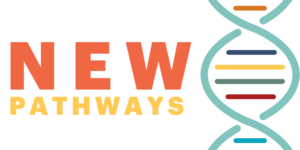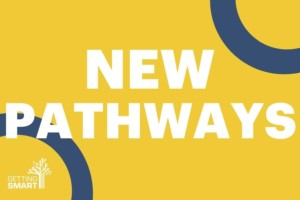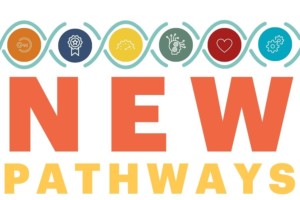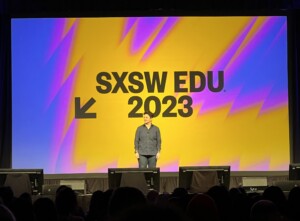Exploring New Pathways at the NVSIDE Conference
Key Points
-
The Nevada Society of Innovators and Digital Educators, NVSIDE, held its in-person Silver State Technology conference at the Lied STEM Academy.
-
It brought speakers on a variety of topics focused on assessments, coding, emerging technologies, robotics, SEL, and coaching with a focus on collaboration and innovation.

The Nevada Society of Innovators and Digital Educators, NVSIDE, which was formerly known as CUE Nevada, held its in-person Silver State Technology conference at the Lied STEM Academy. It was a two-day event that brought in speakers on a variety of topics focused on assessments, coding, emerging technologies, robotics, SEL, and coaching with a focus on collaboration and innovation.
Jhone Ebert, the Superintendent of Public Instruction for Nevada provided an inspiring start to the conference. Throughout her keynote, she shared stories and inspiring words for educators about how to make sure that each student has what they need to thrive in school and life. She spoke about learning recovery and ways that we can focus on helping all students to develop their skills in a variety of ways that meet their interests and needs.
Learning in new ways
For educators to bring about changes to their classrooms, they need to experience a different type of learning. Experiencing the power of choice, hearing from students about the impact of the methods we use, and connecting with other educators to learn together are what make a difference. What I really enjoyed about this event is that it provided a great learning space. The vision of Lied STEM Academy is that “students will acquire the knowledge and skills to actively participate and contribute in a global society.” Throughout the building and in each classroom, you could envision the types of learning experiences that the students have.
At several recent conferences, “learning loss” has been a topic of discussion and many attendees at NVSIDE spoke about the importance of not looking at it as “learning loss” but rather looking at the other skills gained by students. Students learned about digital citizenship and had opportunities to explore new methods and develop tech skills. They were able to learn how to connect and collaborate when not in the same classroom. Educators agreed that we all learned the importance of stretching ourselves, trying new, non-traditional methods, and finding what works for each student to open up new opportunities for them. These insights connect to the six pillars so well.
I focused on the six pillars: unbundled learning, credentialed learning, accelerated pathways, new learning models, support and guidance, and policies and system from the Getting Smart Pathways campaign when selecting my sessions. As we seek to bring in new methods and ideas for students, these pillars are an excellent model to follow. In my own classroom, I like to focus on creating opportunities for students to drive their learning and promote student agency. It is important that our students be able to make decisions about what they are going to create, and that we find ways to connect students with members of our school community or a global community when possible.
When it comes to exploring ideas that expand where, when, and how students learn, finding webinars and conferences is a great way to gather new ideas and even hear directly from students.
Rachelle Dené Poth
New learning models
In order to best prepare students for the future, we need to focus on new learning models in our classroom. Traditional methods still work, but with so many opportunities available that connect our students with real-world experiences, we need to take advantage of those in order to provide more for our students. When we use methods and tools that give students more options for learning, it enhances and can transform the learning experience and ofcourse the learning potential of our students.
Another area that is important at all levels is focusing on the support that we provide and the learning spaces we create for our students. Being able to focus on social-emotional learning (SEL) needs, creating a space for our students where they feel connected to the other learners in their classroom, in a safe and supported environment for them to learn and build their own networks is another one of the pillars that we must focus on. We know that for students to have the best learning opportunities they need to have more power of choice. Learning needs to be authentic, meaningful, purposeful, and relevant for it to boost engagement and amplify learning potential. Bringing in some real-world experiences or offering a variety of ways for students to learn that meet their needs and interests will make a difference for our students.
Experiencing unbundled learning
Some sessions presented were focused on “unbundled learning” and involved promoting more active engagement with blended learning. Unbundled learning means that we provide ways for learning to happen beyond our classroom spaces. What strategies can we use to promote the development of communication, collaboration, critical thinking, and creativity in our classrooms? Trying methods like station rotations, project-based learning (PBL), or genius hour, gives students a chance to work at their own pace, collaborate with classmates, and involve learning that can happen beyond the physical classroom space. When we use these methods, we then find tools to facilitate learning. With the right tools, learning can happen anywhere and provide students with greater choice and agency in how they learn. This is the essence of unbundled learning.
I presented two sessions, one of which focused on creating a space and a culture for learning that will spark curiosity and innovation in our students. I shared one of the digital tools I’ve been using in my Spanish classes, Spaces EDU, which enables students to do a lot of different activities. Students don’t need to stay in our classroom, they can move around the school or their responses can happen outside of the school day and they can connect with one another and with me, which keeps the learning going. I can create individual or group spaces that give them the choice of creating a text response, audio, or video, depending on their comfort level. Using Spaces, students are able to get feedback directly from me and interact with one another. So in addition to being “unbundled learning,” it also offers support and guidance in learning. We can focus on SEL and provide direct feedback to our students. And more importantly, besides building their language skills, they are learning to navigate the digital world and building SEL skills in the process. Using Spaces, students can build confidence in expressing themselves. It also helps them to feel more connected in the classroom and fosters a sense of belonging, which is an alignment with the pillar of “Support and Guidance.”
Bringing in “New learning models,” may be uncomfortable at first, especially for teachers who may have been using some of the same methods throughout their careers. It takes some risk when trying something different but this is a great model to set for our students. With these new learning models, the idea is that teachers are no longer the sole provider of the content but instead the facilitators of learning. Teachers collaborate with and co-learn with students to provide a more personalized learning experience. Using methods like project-based or work-based learning, where students have a choice in what to explore and what to create as evidence of their learning makes a difference in student engagement through real-world applications of learning.
In one of the sessions at NVSIDE, the focus was on student feedback and finding out the best ways to keep students engaged in learning and creating. Asking students for ideas about how to create more interactive learning experiences in the classroom, and what helps them to feel more comfortable and confident in the classroom, is important and aligns with these new learning models. Aligning with the new learning models also means that not everybody has to do the exact same thing, at the same time for learning to happen. A great session was presented by students who shared their ideas for how teachers can incorporate interactive, technology-enhanced activities that will foster students’ creativity, promote choice, and amplify student voice in learning. Sessions like this provide students with tremendous opportunities to build leadership skills and also involve them more in the learning that is happening in and out of the classroom.
Another session that aligned with several of the pillars was “Superstar America’s Next Top Idol,” which focused on how teachers can use music as a focal point to help students build a variety of skills. The idea is that students create, design, and market for the career of a musical character that they create. Using various digital tools, students can build different skills while connecting to an area of interest for them, music. A project like this enables students to choose the direction they take and build skills in collaboration as well as enhance their social awareness in the classroom.
Creating personalized pathways
When it comes to exploring ideas that expand where, when, and how students learn, finding webinars and conferences is a great way to gather new ideas and even hear directly from students. And with the pathways, we are not focused on a “one-size fits-all” or teacher-centered. The “learner experience is co-authored with students” which means we are all learning with and from one another.








0 Comments
Leave a Comment
Your email address will not be published. All fields are required.